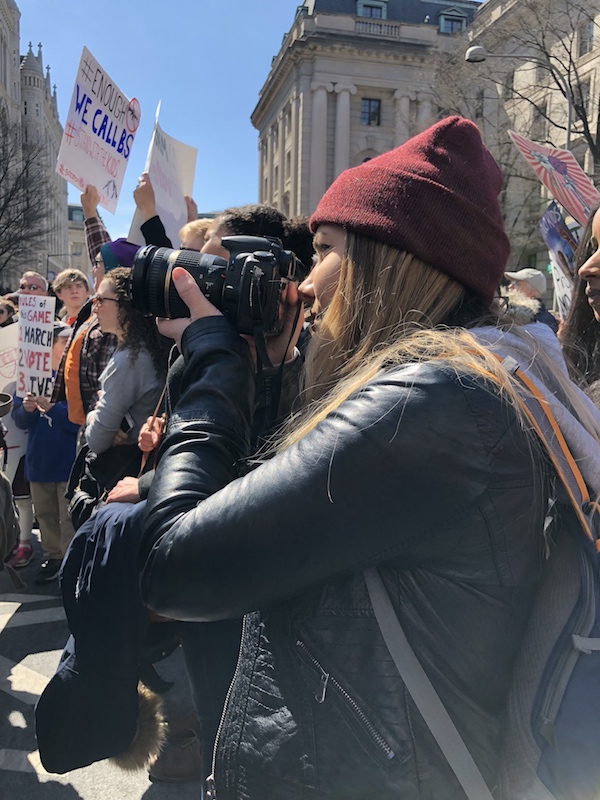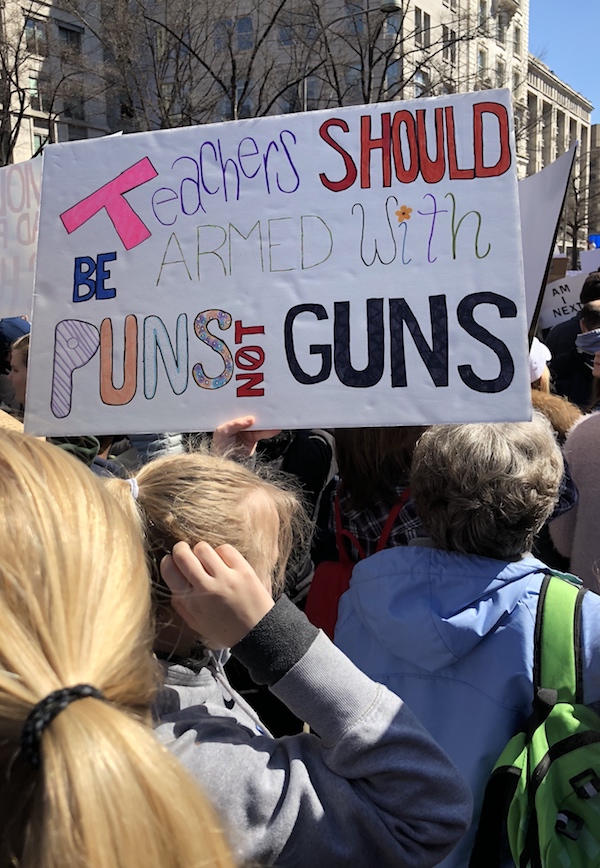On Saturday, March 24th, my 26-year-old daughter and I were among the hundreds of thousands of people gathered on Pennsylvania Avenue in Washington, D.C., for the March for Our Lives. Before following the flow of people with protest signs, we stopped to get coffee and almonds at Starbucks and a cellphone charger from Staples. Before we left the latter, the old journalist in me fully woke up and I bought a pen and a pad of paper small enough to fit in my hand.
We picked out a corner to meet—New York Avenue and 13th Street—in case there was trouble and we got separated. When we reached Pennsylvania Avenue, we grabbed hands and squeezed through the crowd, moving step by small step until we could no longer move. When we stopped, I looked around. To our right, just over the outstretched arms of someone carrying a “Fuck Trump” sign, was Trump International Hotel; on our left, a building marked “1111.” I’m a big believer in signs and that was one I needed to see—“1111” a reminder from the angelic realm to focus on my desires, not my fears; a reminder to trust that all is well.
“What do you think it will look like?” my daughter had asked on the five-hour drive from our homes in rural North Carolina. I’ve only been to one march—the Women’s March in Greensboro, just a little over a year ago. It was quiet and short and wonderful. But I knew this march wasn’t that march. I didn’t know what it would look or feel like. I wasn’t even sure why I was marching, except that my daughter had suggested it, had felt the pull to do more—to do something—to help end gun violence. Her tipping point from inaction to action came after she read about children being told not to wear light-up shoes—the kind her 6-year-old son wears—to school because it would make them an easy target for a school shooter.
When she asked me to go with her to the march, I said “yes” without hesitation.
Now that we were standing under clear blue skies in the midst of the march, I still didn’t know what to expect. If I stood on my tiptoes I could see the United States Capitol off in the distance and a Jumbotron a block or so away broadcasting the people who were speaking or singing on stage. Most I didn’t know and couldn’t hear, their words bouncing off of the buildings. After an hour or so I wondered if we were ever going to move or if this “march” was really a “stand.” But before negativity could take hold, I shifted my thoughts. I was standing on Pennsylvania Avenue on a beautiful spring day, surrounded by people who were willing to stand up for something they believed in. My daughter was one of them.
She stood beside me now, peering through the lens of my old Canon 20d. She stood on her tiptoes to shoot a crowd shot up Pennsylvania Avenue. She tapped a woman wearing a hijab and asked if she could take a photo of her with her sign: “Why doesn’t the NRA push black people to hoard guns?” She took a photo of someone holding an American flag with the Trump hotel in the background. She waited patiently for a marcher to turn so she could get a clear shot of their sign: “Pro Life? Prove It!”
She captured moment after moment—not because she planned to do anything with the photos. Being behind the camera, she told me, allowed her to zero in on the good, to watch and listen without dissolving into anger.
While I figured I would interview people and take photos, too, the pen and pad of paper stayed in my pocket and the camera in my daughter’s hands. Occasionally I reached for it—to take a photo of a little boy in a wheelchair holding a sign or the gray-haired woman with the rhinestone-studded sunglasses who had scrawled “Never Again” on the back of her brown wrists—but mostly I watched my daughter doing what I had always loved to do but doing it in her own way for her own reasons.
The baton passed quietly between us.
That wasn’t the case for the young people leading this movement against gun violence. The baton was thrust into their hands by the action of those with guns who took the lives of their friends and family members—and the inaction of elected officials to do anything about it.
In a New York Times article, Lane Murdock, a 15-year-old high school student in Connecticut, said, “We were raised to let the adults do the work.” According to the article, she was “jarred out of complacency” by a combination of gun massacres and Donald Trump’s surprise win. She was now planning walkouts at her school.
I, too, have been jarred out of complacency—by my daughter and by those who spoke during the march in D.C. Although I couldn’t hear many of the speeches, Emma Gonzalez’s powerful words made their way to me. I stood again on my tiptoes and watched as she abruptly ended her speech and stood courageously in the uncomfortable silence until she logged six minutes and 20 seconds on stage—the length of the time the shooter spent gunning down students at her high school in Parkland, Florida.
Back at home three days later, I feel unsettled. There’s more to do and yet I don’t know what’s mine to do. I won’t blindly follow anyone, but I do know this for sure: I’m listening to these young people. I’m looking to them for my marching orders.
They are the change—and I am changed by them.
Photos by Jess L. Boyer




































